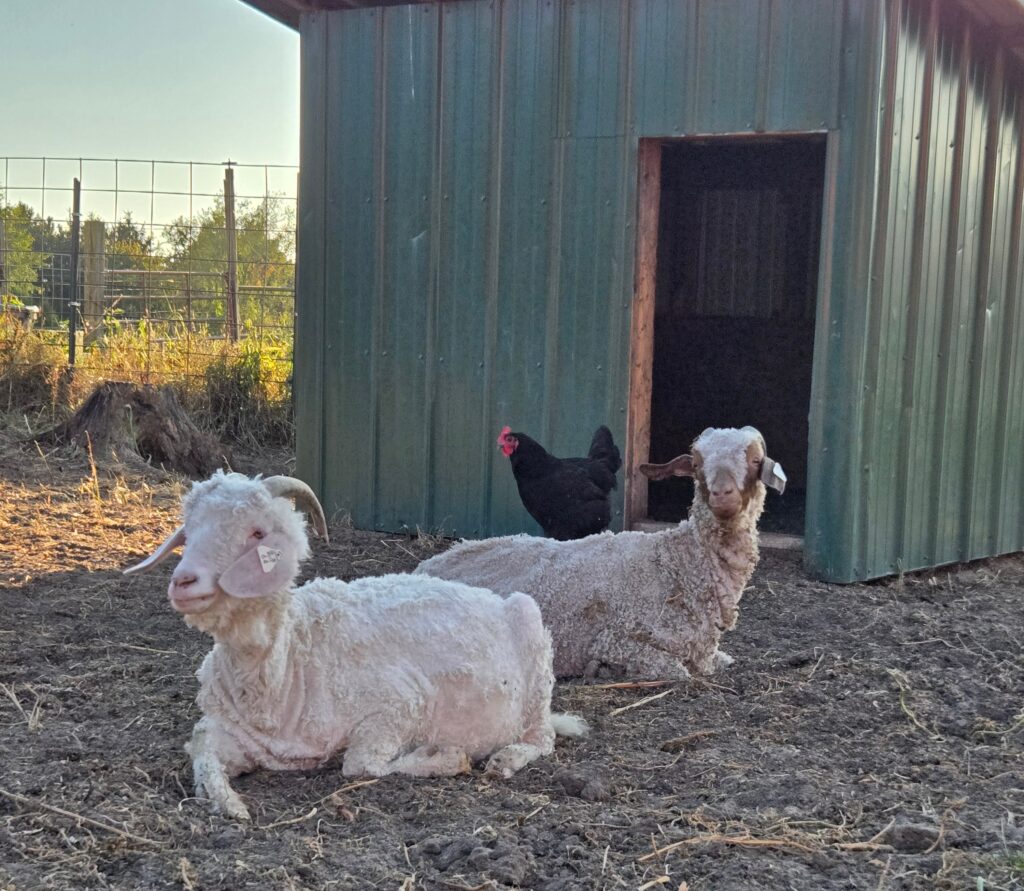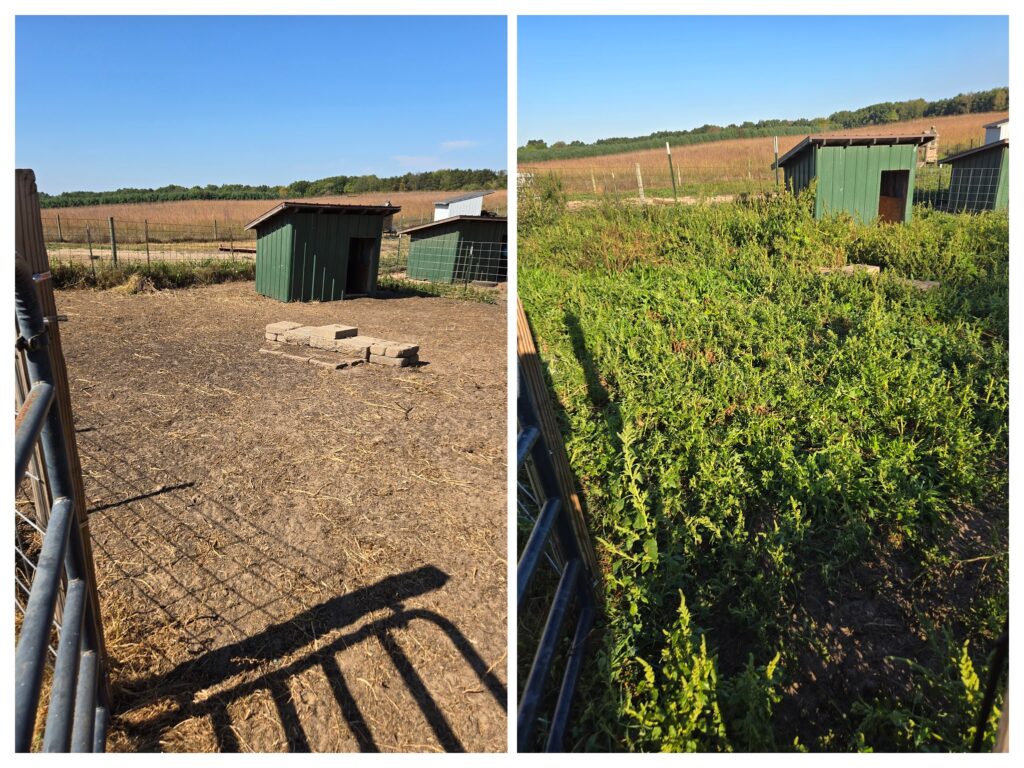Before you bring home new livestock, there are a few housekeeping tasks you should have completed. If you follow this checklist, you will ensure the safety of your new animals and minimize the likelihood of them contracting pathogens from the animals housed there previously.

This post contains affiliate links. As an Amazon Associate, I earn from qualifying purchases.
So, you pulled the trigger and put down a deposit on some new livestock. Was it a pair of irresistible goats? Lambs? Piglets? A donkey?
Regardless of the species, it’s important that you are adequately prepared before you pick them up and bring them to your property.
You may be thinking, I’m already prepared, I have a barnyard full of animals, plenty of feed, and an open pen. I’m all set!
While that arrangement seems appropriate on the surface, it can be a recipe for disaster. Let me explain why.
The Link Between Stress and Immunity
For many animals, moving to a new home is stressful. They probably endured fear and confusion in all or some parts of the loading, transportation, and unloading process.
As expected, separated from their companions and in an unfamiliar place, it will take some time for the animals to become accustomed to their new surroundings. In the meantime, they will endure stress and the associated physical, psychological, and immunological implications that come with.
There is plenty of evidence to support the idea that stress negatively impacts immune function. Research in the cattle industry reveals the link between transportation stress and respiratory diseases (Earley, Buckham Sporer, and Gupta, 2017). Similarly, research on swine indicates that social stresses such as regrouping, crowding, and weaning correlate with gastrointestinal disease (Gisma, Tuchscherer, and Kanitz, 2018).
Stress, when in combination with changes in diet and surroundings, puts animals at higher risk of contracting disease. Therefore, exposure to hazards as well as virulent bacteria, viruses, and fungi during periods of acute stress should be minimized.
Tips for Minimizing Stress on Relocated Animals
If you are wondering how you can minimize stress for your newly acquired animals, don’t worry. There are several best practices you can employ to help your animals adjust.
A single animal in a new place will be more stressed than one that is relocated with a herdmate. Purchasing animals in pairs or groups is one easy way to minimize stress.
Another recommendation to minimize stress is to change feed gradually. When you purchase new animals, ask what kind of grain they were previously on. If you want to switch to a new feed, begin introducing the new feed a little bit at a time. Over a period of at least a week, you can make the transition without causing stomach upset or risk the animals going off feed.
Last but not least, practice quarantining for stress control and biosecurity.
Quarantine for New Animals
It is recommended that new animals be quarantined, even if they look healthy. The United States Department of Agriculture guidelines suggest a quarantine period of 21 to 30 days for new livestock. The quarantine area should be a quiet space separate from other animals on the farm.
Isolating new animals will allow them to become acclimated to a new environment without extra stimuli. In addition, it will help the farmer observe their behavior and notice any signs of disease.
Once the quarantine period is over, your animals are ready to go into their new pen. Here are the steps to make sure it’s ready for them!

1. Check for Safety Hazards in the Animal Pen
Before your new animals go in an old pen, its important that you check it for any safety hazards. Verify the integrity of the fence, a frightened new animal is sure to find any weak spots and you don’t want them to escape!
Once you know the perimeter is solid, examine the rest of the enclosure. Look for holes that need to be filled or anything loose or sharp that could be a potential problem.
2. Manage Vegetation in the Animal Pen
You will want to make sure that whatever is growing in the pen is safe for the species of animals you plan to put there. If you find any toxic plants, you will want to dig them up instead of just lopping them off.
You may need to mow or weed whack if the pen is severely overgrown. Consider creating a dry lot if the pen was previously inhabited by animals with parasite issues. A dry lot is an animal enclosure that is free of vegetation, essentially just bare ground.
For many animals, grass or other vegetation is a necessary vector for parasite transmission. The parasite cycle works like this: an animal with parasites sheds worm eggs in their feces, the eggs hatch into larvae, the larvae leave the feces and move up to 3 inches in the grass, animals ingest larvae while grazing on the grass, and the cycle repeats itself. By eliminating the vector of vegetation, you can curb the parasite infestation of your herd.
3. Clean Up Manure in the Animal Pen
Grab your pitchfork! In addition to managing the vegetation, it’s a good idea to get rid of any manure that is in the pen that you want to use for new animals. Unfortunately, you can’t disinfect the soil, but you can make the environment as clean as possible by clearing out any piles of feces left behind.
As previously mentioned, fecal matter is a source of parasite contamination that you want to minimize your new animal’s exposure to.
4. Disinfect the Shelter in the Animal Pen
Solid structures like barns, run-ins, and sheds should be disinfected before you let your new animals use them. On our farm, we use household bleach as a disinfectant. We dilute the bleach with water to make a 5% bleach solution. We put ½ cup of bleach and 1 gallon of water in a handheld sprayer and use that to douse the shelter.
Bleach is nice because it is cheap, but it can discolor or corrode some surfaces. Using vinegar instead of bleach is another option. If you want something stronger, there are an array of surface disinfectants you can buy at your local farm store.
5. Sanitize Feeding and Watering Equipment in the Animal Pen
In addition to disinfecting the shelter, you will want to carefully clean and sanitize the feeding and watering equipment that your new animals will use. To remove algae and other contaminants, we scrub buckets and troughs with toilet bowl brushes bought specifically for that purpose.
To sanitize buckets, we use a dilute 5% bleach solution (see mixing instructions in the section above). We put the bleach solution in the bucket and let it sit for 10 minutes, then rinse it out thoroughly with fresh water.
References:
Earley, B., Buckham Sporer, K., and Gupta, S. (2017). Invited review: Relationship between cattle transport, immunity and respiratory disease. Animal, 11(3), 486-492. doi: 10.1017/S1751731116001622
Gimsa, U., Tuchscherer, M., and Kanitz, E. (2018). Psychosocial stress and immunity- What can we learn from pig studies? Frontiers of Behavioral Neuroscience, 12,64. doi: 10.3389/fnbeh.2018.00064
United States Department of Agriculture Animal and Plant Health Inspection Service. (2012). Biosecurity in Small-scale U.S. Livestock Operations. https://www.aphis.usda.gov/

Mother, farmer, author, and teacher by trade… She loves tending to things and watching them grow!
